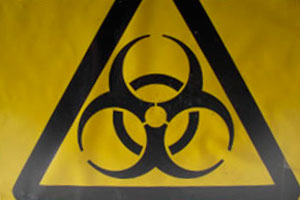
Hazardous Waste Warning
LessIsMore.org works best in modern browsers like Firefox, Safari, Chrome, or Internet Explorer 8. All are free to download and will greatly improve your internet experience. Wastes in this section are dangerous to you and the environment. Handle them carefully and dispose of them properly. Legally, households may not transport more than 15 gallons of wet or 125 pounds of dry hazardous materials. Read about the regulation.
Pool Supplies
As much as we may dislike the smell of pool chemicals, the alternative can be just as unappealing. An untreated pool is the perfect breeding ground for harmful pathogens (think icky bacteria and other disease-carrying microorganisms).
What kinds of chemicals are used?
To keep pathogens at bay, pool owners use disinfectants, the most popular of which is chlorine. In compound form, chlorine is commonly available as calcium hypochlorite and sodium hypochlorite.
Bromine is another common pool sanitizer. Because it is more stable than chlorine in warmer water temperatures, bromine is often used in spas and hot tubs, too.
When a pool's pH level becomes unbalanced, other chemicals are used to either lower or raise the pH. Hydrochloric acid, also called muriatic acid, is frequently used for this purpose. Acids reduce the pH level. Another popular pool acid is sodium bisulphate.
To increase pH levels, bases are used, such as soda ash (sodium carbonate).
Where to go
-
All of Santa Barbara County (1)
- Safety Kleen — 5310 Overpass Road
-
Santa Barbara Area (1)
- *Community Hazardous Waste Collection Center — University of California, Environmental Health and Safety Building, Building 565, Mesa Road
-
Goleta & UCSB Area (1)
- *Community Hazardous Waste Collection Center — University of California, Environmental Health and Safety Building, Building 565, Mesa Road
-
Lompoc Valley & VAFB (1)
- City of Lompoc Household Hazardous Waste Collection Facility — 1585 N. "V" St
-
Santa Maria Valley (1)
- City of Santa Maria Household Hazardous Waste Facility — 2065 East Main Street
-
Outside Santa Barbara County (7)
- Asbury Environmental Services — 2100 North Alameda Street
- BGI — 527 North Rice Avenue
- C.J. Seto Support Services, LLC — 2300 Knoll Dr, Unit G
- Clean Harbors, Inc. — 880 W Verdulera St
- Earth911.com – Information Only — 3481 Plano Parkway
- Industrial Waste Utilization — 5601 State Street
- Stericycle, Incorporated —
Related Materials
- Santa Ynez Valley Collection Event
- Recycling Resource Guide
- Pool Supplies
- Home Improvement Items/Supplies Reuse
- Cleaning Products
Related Articles
-
April 7th Hazardous Waste Collection Event
March 03, 2019 by Leslie Robinson - Hazardous Waste Recycling/Disposal -
Holiday Facility Closures
December 20, 2023 by Tori Kampmann - Hazardous Waste Recycling/Disposal -
“Less Is More” Guide Hot Off the Press
January 18, 2023 by Kaitlyn Haberlin - Recycle, Reduce & Reuse -
America Recycles Day November 15th
November 08, 2019 by Leslie Robinson - Recycle -
Latest Annual Report Available for County’s Hazardous Waste Collection Program
January 10, 2024 by Tori Kampmann - Hazardous Waste Recycling/Disposal -
Thomas Fire Clean-Up Tips & Guidelines
-
Thanksgiving Facility Closures
November 22, 2023 by Tori Kampmann - Hazardous Waste Recycling/Disposal -
RRWM’s Annual Waste Management Report Now Available
October 05, 2017 by Alan Nakashima - Recycle -
Easy Battery Recycling at Curbside
May 31, 2019 by Jody Rundle - Hazardous Waste Recycling/Disposal -
Battery Recycling Made Easy
November 30, 2015 by Jody Rundle - Hazardous Waste Recycling/Disposal -
Free Hazardous Waste Events October 5 & 6
September 30, 2019 by Leslie Robinson -
Reminder: Santa Ynez Valley Hazardous Waste Collection Event Postponed
March 23, 2020 by Leslie Robinson -
Hazardous Waste Collection Center Temporarily Closed – Updated 3/30/20
March 30, 2020 by Leslie Robinson - Hazardous Waste Recycling/Disposal -
Hazardous Waste Disposal Options in Santa Barbara County
June 04, 2021 by Tori Kampmann - Hazardous Waste Recycling/Disposal -
FREE Household Hazardous Waste Event!
March 31, 2024 by Kaitlyn Haberlin - Hazardous Waste Recycling/Disposal